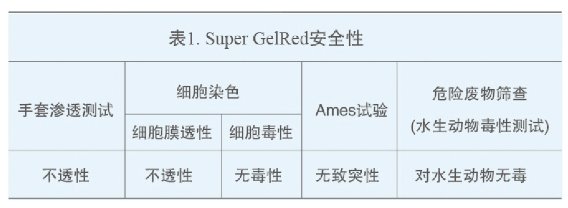M401 Super GelRed 10,000X in Water
Please click the link below to download the manual | M4011 |
Product Specification | 0.5ml/Branch |
Product Price (Yuan) | 528 |
详细说明
Product Description
Super GelRed is a highly sensitive, low toxic and ultra safe nucleic acid gel electrophoresis fluorescent dye reagent. It can replace EB, and its sensitivity is much higher than that of EB, and it does not need to decolorization. Because super GelRed and EB have the same spectral characteristics, there is no need to replace the imaging system when replacing EB.
Product Features
Safe and non-toxic: the unique oily and high molecular weight characteristics make it unable to penetrate the cell membrane and enter the cell. The Ames test results show that its mutagenicity is far less than EB. The water-soluble dye has passed the safety certification of the US Environmental Protection Agency. The waste can be directly poured into the sewer without causing environmental pollution.
High stability: it can be heated directly in microwave oven. It is extremely stable in acid or alkaline buffer at room temperature. It has strong light resistance and can be stored at room temperature.
High sensitivity: the sample has strong fluorescence signal and low background signal, which has less effect on nucleic acid migration than SYBR Green I.
Simple operation: like EB, the dye does not degrade in the process of preformed glue and electrophoresis; Dyeing after electrophoresis also takes only 30 minutes without decolorization or cleaning.
Wide range of application: you can choose pre electrophoresis dyeing (glue dyeing) or post electrophoresis dyeing (bubble dyeing); It is suitable for agarose gel or polyacrylamide gel electrophoresis. It can be used for dsDNA / ssDNA or RNA staining.

Super GelRed Safety Report
Super GelRed has been highly praised by scientific researchers for its excellent safety, which is mainly reflected in the following aspects:

1. Glove penetration test
The fingers of gloves were treated with TAE solution and 5x & nbsp; The Tae solution of super GelRed was dialyzed for 48 hours, and the fluorescent dye intensity of the liquid in the finger was analyzed.

Figure 1 . Super GelRed glove penetration test
Results: the same as 1x & nbsp; The fluorescence intensity of super GelRed (red) is compared with that in gloves & nbsp; The fluorescence of super GelRed (green) is negligible, indicating that super GelRed cannot penetrate latex gloves.
2. Cell permeability test
Hala cells were incubated at 37 ℃ for 5 min (a) and 30 & nbsp; min(B),wiih 1×SYBR Safe、1×SYBR Green and 1×Super GelRed

Figure 2 Cell membrane permeability test
Results: under the same conditions, SYBR safe and SYBR Green could rapidly penetrate the cell membrane and stain the DNA in living cells, while super GelRed could not penetrate the cell membrane of living cells.
3. Ames test
Comparing the mutagenicity of super GelRed, SYBR Green I and EB to the transferred Salmonella strain TA98 lacking S9 fragment, the black arrow indicates that EB is not tested at this concentration, and the gray arrow indicates that SYBR Green I shows mutagenicity at this concentration.
Results: Super GelRed showed no mutagenicity in the whole concentration range; EB was consistent with the literature report, and had no mutagenicity to the strain without S9 metabolic activity; SYBR Green I from 1 μ G / ml, showing gradually stronger mutagenicity.

Figure 3 Ames test of Salmonella without S9 metabolic activity
Compare the mutagenicity of super GelRed, SYBR Green I and EB to the transferred Salmonella strain TA98 with S9 fragment. The black arrow indicates that EB is not tested at this concentration, and the gray arrow indicates that SYBR Green I shows mutagenicity at this concentration.
Results: Super GelRed was only 50 μ When the concentration of g / ml was high, it showed weak mutagenicity& nbsp; SYBR Green I shows mutagenicity at high concentration; EB had high mutagenicity to strains with S9 metabolic activity;

Figure 4 Salmonella Ames test with S9 metabolic activity
4. Aquatic animal toxicity test
This test evaluates the acute toxicity of super GelRed to aquatic organisms.
Result: 3 ×& nbsp; Super GelRed is not toxic to aquatic organisms, so 3x or lower concentration of super GelRed can be safely released into the environment.










 关闭返回
关闭返回